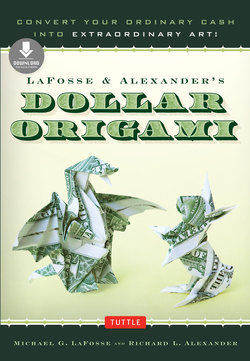Читать книгу LaFosse & Alexander's Dollar Origami - Michael G. LaFosse - Страница 8
ОглавлениеOrigami Symbols Key
Our diagrams use the standard origami notations that are shown here. If you are new to origami notation, please be encouraged that the project diagrams are complete and clear. However, your ability to easily interpret them will take time, like learning to read any foreign language. Studying from both the video lessons and the diagrams will help you to learn to read origami instructions much more quickly.
General Tips
Clean, crisp money is easier to fold, and new bills always work best. When selecting a bill for an origami subject, look for one that is printed symmetrically (equal margins all around, and the printed images are registered so that the fields align when held to the light). If your bills are limp, they can be gently ironed, but first place them between sheets of paper so the plastic inclusions do not mar the iron’s hot surface.
U.S. one dollar bills are remarkably strong, and for origami, they tend to be a bit stiff. For this reason, most dollar bill folders add a slight amount of moisture, either by swiping the bill with a moist napkin or towel, or with just a light spritz from a plant mister.
Consider gathering a few tools to make your results look neat and crisp: 1) a “bone” folder helps when setting sharp creases—or a coin, or even the bowl of a spoon; 2) a pair of fine tweezers helps to pull edges into proper alignment, and details into final position; 3) a bamboo skewer is useful for opening eyes and mouths on your miniature creatures; and 4) a pair of nylon jaw jewelers’ pliers will help you concentrate force to properly set multi-layer points and flaps.
Lee’s Coin Pouch
Designed by Richard L. Alexander
My father, Lee Alexander, has carried a rubbery plastic clamshell coin pouch ever since they were first developed. They used to be a popular tangible advertising item, and by carrying just a few coins, it prevented him from receiving handfuls of coins as change. Folding a similar object from a dollar bill goes one step further: It is lighter, thinner, and more compact. But best of all, if you get in a pinch, you will always have one dollar more than the sum of its contents!
1 Begin with the obverse side up. Mark the center of a long edge with a short valley fold pinch mark.
2 Valley-fold the short edges to meet at the middle.
3 Turn over, left to right.
4 Valley-fold the folded edges to meet at the middle. Allow the back edges to come to the front.
5 Move the top right flap to the left.
6 Valley-fold the corners of the right flap to the vertical crease. Valley-fold the left edge of the top flap the vertical crease.
7 Valley-fold the left flap to the right.
8 Mirror steps 5 through 7 on the left.
9 Open the pocket through the folded slit. This is the back of the coin pouch. Turn over.
10 Lee’s Coin Pouch.
Canoe
Designed by Richard L. Alexander
There must be a million ways to float the dollar, but this is one that our government probably hasn’t tried yet. This may be the simplest of many one dollar canoes, and we hope it will become the springboard for a flotilla of more complex cash craft from you, Creative Captains of Crease. It makes a great chopsticks rest.
1 Begin with the obverse side up for a green canoe. Valley-fold the left and right short edges to the top edge.
2 Valley-fold all of the layers of the top edge down to form a folded margin. Unfold.
3 Unfold the left and right triangle flaps.
